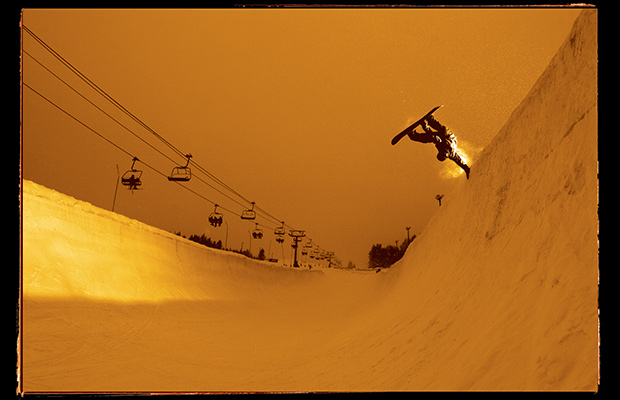 I have a dark secret. Many moons ago, as a young whippersnapper, I used to ski. I was one of those kids you see in resort with the tiny little goggles and metre long skis, hooning down slopes in the ‘racing snowplough’ position. My life changed when I got into skateboarding with a few mates from school, then discovered its mountain equivalent on a trip to Switzerland in ‘91. Even though I was just a grom, snowboarding seemed so much more free, so much more fun, than skiing. On the hill, powder became something you floated over with a grin rather than waded through with your poles (remember, this was before powder skis) and you didn’t need years of lessons in how to do a parallel turn properly before you could hit decent jumps or express yourself through lines. Off the hill, snowboard boots were actually comfortable to walk around in, and you could carry your set-up neatly under your arm without slinging bits and pieces over your shoulder like some clown with a ladder. And the people, the riders themselves… well, they were just younger than the skiing crowd, less obsessed with racing and more imaginative. Happier, basically. And like my skateboarding heroes, the pros back then were rocking it!
I have a dark secret. Many moons ago, as a young whippersnapper, I used to ski. I was one of those kids you see in resort with the tiny little goggles and metre long skis, hooning down slopes in the ‘racing snowplough’ position. My life changed when I got into skateboarding with a few mates from school, then discovered its mountain equivalent on a trip to Switzerland in ‘91. Even though I was just a grom, snowboarding seemed so much more free, so much more fun, than skiing. On the hill, powder became something you floated over with a grin rather than waded through with your poles (remember, this was before powder skis) and you didn’t need years of lessons in how to do a parallel turn properly before you could hit decent jumps or express yourself through lines. Off the hill, snowboard boots were actually comfortable to walk around in, and you could carry your set-up neatly under your arm without slinging bits and pieces over your shoulder like some clown with a ladder. And the people, the riders themselves… well, they were just younger than the skiing crowd, less obsessed with racing and more imaginative. Happier, basically. And like my skateboarding heroes, the pros back then were rocking it!
I was reminded of all this recently when I was invited to take part in a debate on the radio. The idea was to pit me against a ski mag editor, and the subject of the argument was to be that hoary old question: which sport is better? No doubt the organizers were hoping for a good old slanging match, but what they’d failed to realize was that a lot of years have past since people like me ditched the skis for a snowboard, and to be fair, much has changed in the skiing world. Following snowboarding’s lead, they incorporated sidecuts into their skis, and developed twin tips and powder skis; a younger generation even began dressing like snowboarders and pulling crazy tricks. These new school kids (now christened ‘freeskiers’) hit the same jumps we do – sometimes, thanks to the length of their skis, going even bigger than we can; they pull ‘720s’ and ‘rodeos’ and (gay as it sounds to me) they’ve taken to calling their grabs things like ‘indy’ and ‘mute.’ In short, something of snowboarding’s identity has been stolen, and while I’m not about to trade back my snowboard for a pair of Salomon 1080s, the idea of taking sides on the radio over some stale notion of a great divide seemed stupid. Get down to your local AIM Series event and see for yourself – it’s not as simple as old versus young anymore, the Jester-hatted ‘Tarquin’ brigade versus the hip young snowboarder.
All of which begs the question: why do I still ride rather than ski? Is it just force of habit, or something deeper? Well, as Dave Downing quipped recently, “it’s hard to have style when you’ve got poles in your hand,” and never a truer word was spoken! But if I wanted a little more inspiration I need look no further than Mr. Terje Haakonsen, with whom we scored a rare interview this month.
Many of the early pros – Jamie Lynn, Jeff Brushie, Noah Salasnek, Shaun Palmer and others – had a role in making snowboarding the sport it is today, but none of them have had such a profound or lasting effect as the man known as the “Sprocking Cat’. Terje has won more contests than any of them, invented more tricks, had more memorable video parts and developed more snowboards. What’s more, he’s still ripping today. Watch him pick lines through natural terrain and that is the only answer you’ll ever need to the question of why we ride.
Terje old schoolLike me, Terje began his love affair with the mountains on skis, being brought up in traditional Norwegian fashion – and having found a similar freedom in standing sideways he too has never looked back. Through all the changes both in skiing and snowboarding – the fashions and the riding styles, the marketing and the politics – Terje has stayed true to his own brand of riding, which is as timeless as his covershot on this very magazine. An accomplished surfer and skater, it seems fair to say that Terje is more than just a snowboarder: he is symbolic of the link between our own sport and the wider boardsports culture. People can argue that skiers and snowboarders are both just sliding down mountains, and the freeskiing crew can ape our way of doing it all they like, but there’s a creative spirit in snowboarding – embodied in Terje – that has come directly out of our kindred sports in the water and on the street. The pioneers of snowboarding were all skaters or surfers, riding not just to win but to have fun with their friends and, as Mike Basich put it so well last month, for the “pure joy” of it. It was this free-thinking philosophy that sparked all the soul-searching when snowboarding was introduced to the Olympics, and which led to Terje boycotting the Games. He believes there are other ways of growing the sport without putting it into the hands of others and compromising its ideals. The quarterpipe event he organized in China, also featured in this issue, is a classic example.
As Terje experienced first hand, moreover, snowboarding was once on the fringes of acceptability, and this fact still marks it out from skiing. We might be loved by the mainstream now, with everyone from the BBC to Hewlett Packard getting in on the act, but snowboarding’s character developed during a period in which it was looked down upon by traditional skiers and at times even banned outright. Hence the mutual dislike that reigned for a while. And for all its recent acceptance of snowboarding (at least by the younger generation, or those looking to make a buck) skiing has never had to worry about gaining recognition. It has always been accepted as a so-called ‘proper’ sport, and for its own part has never had a problem accepting the money-spinning hype and hard-nosed competitive attitude masquerading as the ‘spirit of the Olympics’. And it’s never had a Terje.
Terje new school
